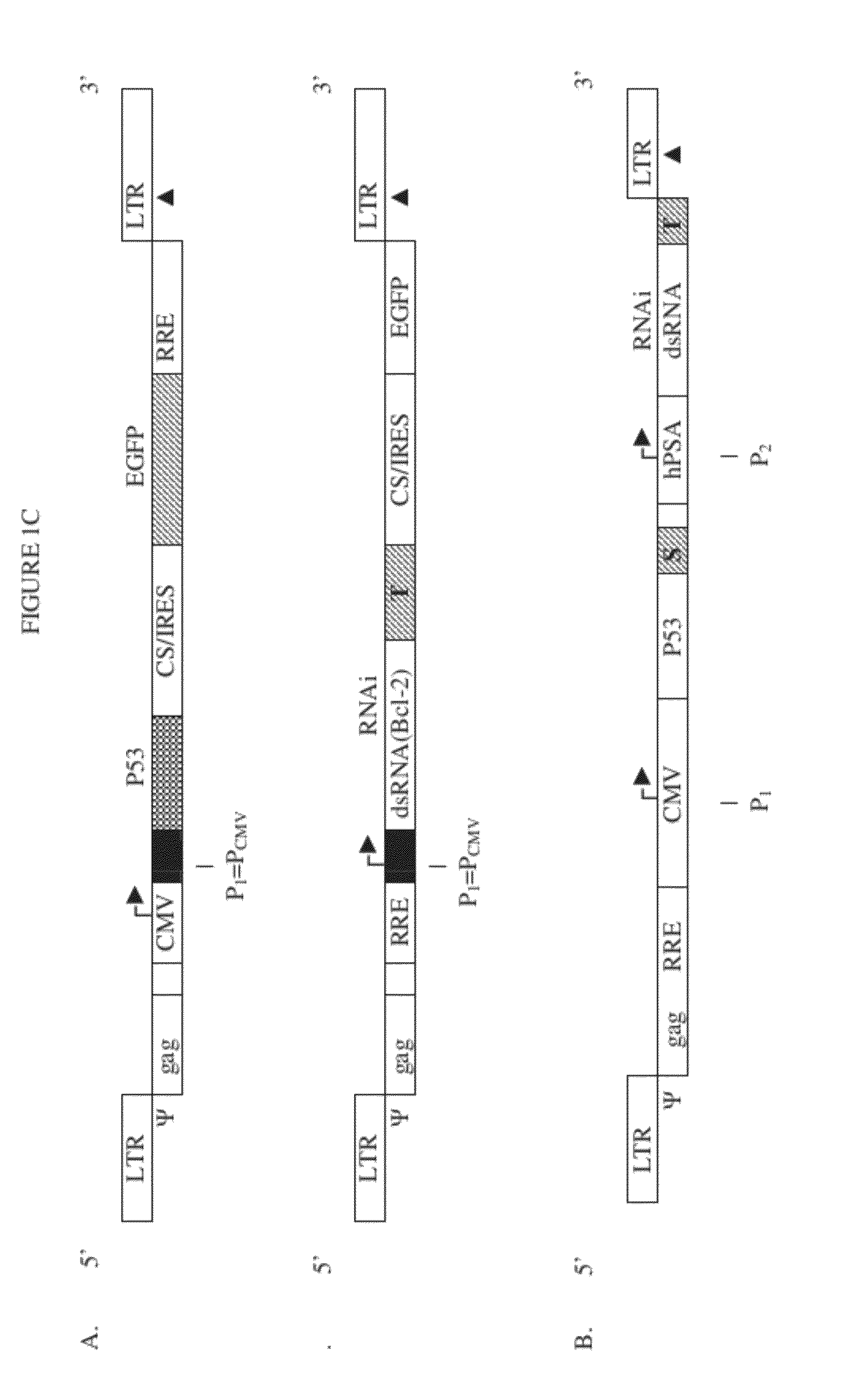Safe lentiviral vectors for targeted delivery of multiple therapeutic molecules
a lentiviral vector and targeted technology, applied in the field of medicine, can solve the problems of difficult in vivo delivery of sirna for long-term expression in target cells and tissues, limitations of researchers' development of virus vectors, etc., and achieve the effect of supporting expression efficiency and preventing further unwanted infectivity
- Summary
- Abstract
- Description
- Claims
- Application Information
AI Technical Summary
Benefits of technology
Problems solved by technology
Method used
Image
Examples
example 1
nstruction
[0188]The additional components of the gene transfer system include a packaging (helper) plasmid and an envelope (Env) plasmid encoding VSV-G driven by the HIV-1 LTR (Mochizuki, H. et al., 1998, J Virol 72:8873-8883; Reiser, J. et al., 1996, PNAS USA 93:15266-15271). These packaging and envelope constructs are described herein and by Lai et al., 2000, PNAS, 97: 11297-11302, and Lai, et al., 2002, Neurosci. Res. 67: 363-371, incorporated herein by reference. The helper construct has a deletion in the packaging signal rendering it inactive, and the 5′ LTR is replaced with the CMV-IE promoter. The CMV promoter was derived from pcDNA 3.1, which was used as a template for a PCR reaction yielding 590 by of the CMV promoter. The HIV-1 helper construct was digested by EcoRV (33) and Afl II (517) to have generate a deletion of 475 by from the U3 region of the 5′LTR. Insertion of the CMV promoter PCR fragment was then ligated into the HIV-1 helper construct to create a safer Tat-ind...
example 2
Infection of a Prostate Cancer Cell Line with SIN-HIV-P53-EGFP
[0190]PC-3 (prostate cancer) cells were infected with a lentivirus containing a gene transfer vector expressing wild-type P53 and EGFP. Three groups were tested. Treatment group: PC-3 cells were treated with SIN-HIV-P53-EGFP (construct shown in FIG. 6). Control (negative) group: PC-3 cells were untreated. Control (positive) group: Normal cells were treated or not treated with SIN-HIV-P53-EGFP.
[0191]Prostate cancer cell-lines (PC-3) and 293-T cells were placed into the 12 well-plate with 0.4×106 cells, and were cultured in the RPMI 1640 and DMEM medium containing antibiotics. 200 μl of the packaged lentiviral vector SIN-CMV-p53-IRES / CS-EGFP (see FIG. 1C) was added to the cells for the infection study under 1 mg / ml. The cells were then cultured by incubating for 6-16 hours at 37° C. in a CO2 incubator. After infection for 48-72 hours, we evaluated the expression of EGFP using a fluorescence microscope in both the transduced...
example 3
ransduction with SIN-HIV-P53-EGFP and SIN-HIV-P53-Bcl-2 RNAi
[0195]Transduction with the SIN-HIV-P53-EGFP vector described in Example II, expressing P53 and GFP, or SIN-HIV-P53-Bcl-2 RNAi , expressing P53 and an RNAi agent targeting human Bcl-2, is done in vivo. See FIG. 1C, Panel B, upper construct (CMV-P53-hPSA-Bcl-2 RNAi). The NOD SCID mouse model, characterized by a major immunodeficiency, is used to study gene therapy for prostate cancer using lentiviral transfer systems of the invention.
[0196]NOD SCID mice are subcutaneously implanted with a PC-3 cell suspension in a thoracic postero-lateral wound. Tumor cell suspensions are injected using a 30-gauge needle and a 1-ml disposable syringe. The volume of inoculation is 100 pi (2×106 tumor cells suspended in 100 μl of PBS). After tumor appearance (1-2 weeks post-implantation), the virus injections are made.
[0197]Tumor progression is monitored by palpation twice a week by the investigator, and subcutaneous tumor size is measured usi...
PUM
| Property | Measurement | Unit |
|---|---|---|
| Tm | aaaaa | aaaaa |
| Tm | aaaaa | aaaaa |
| volume | aaaaa | aaaaa |
Abstract
Description
Claims
Application Information
 Login to View More
Login to View More - R&D
- Intellectual Property
- Life Sciences
- Materials
- Tech Scout
- Unparalleled Data Quality
- Higher Quality Content
- 60% Fewer Hallucinations
Browse by: Latest US Patents, China's latest patents, Technical Efficacy Thesaurus, Application Domain, Technology Topic, Popular Technical Reports.
© 2025 PatSnap. All rights reserved.Legal|Privacy policy|Modern Slavery Act Transparency Statement|Sitemap|About US| Contact US: help@patsnap.com



